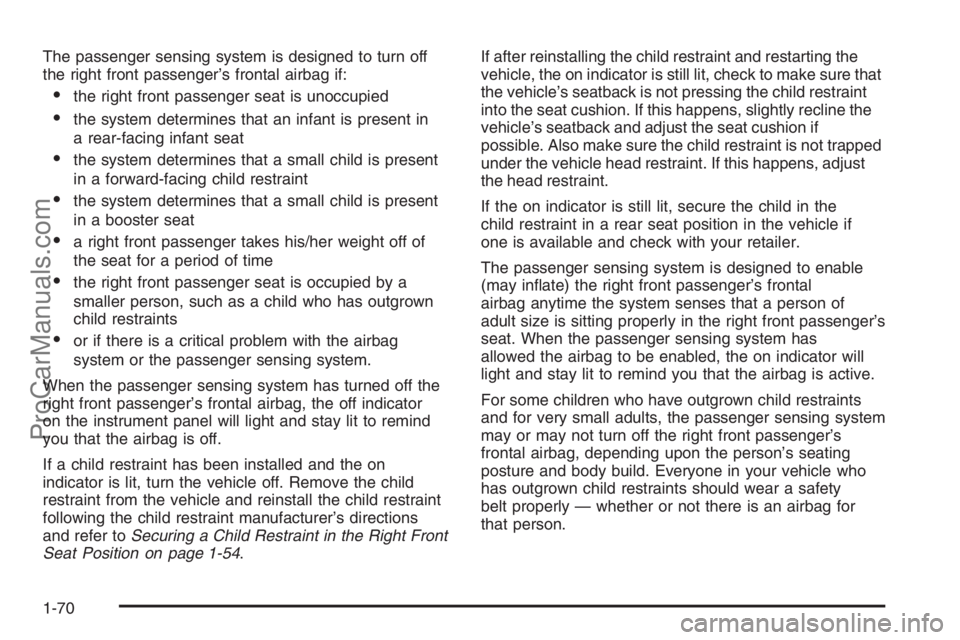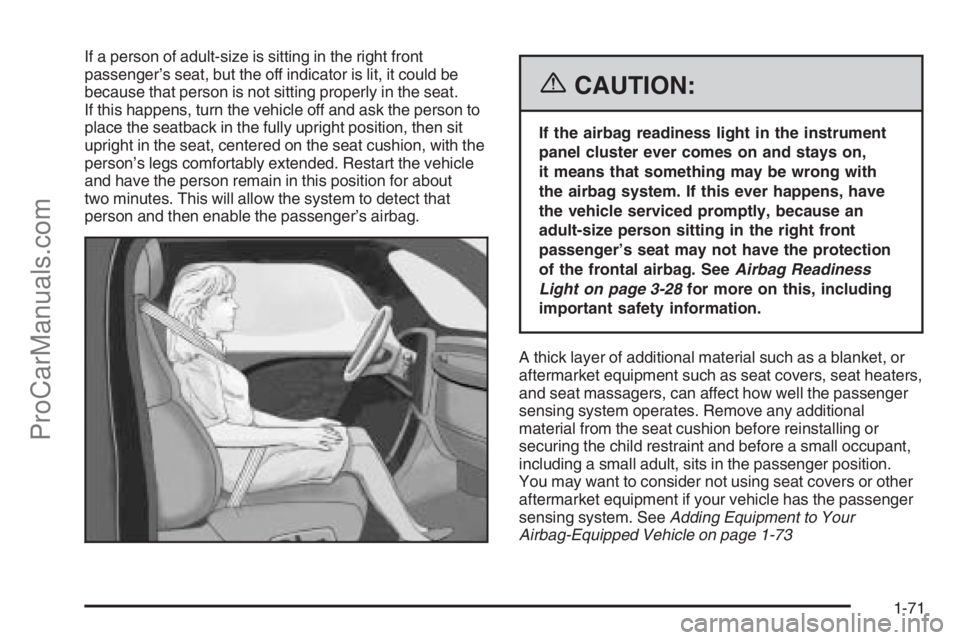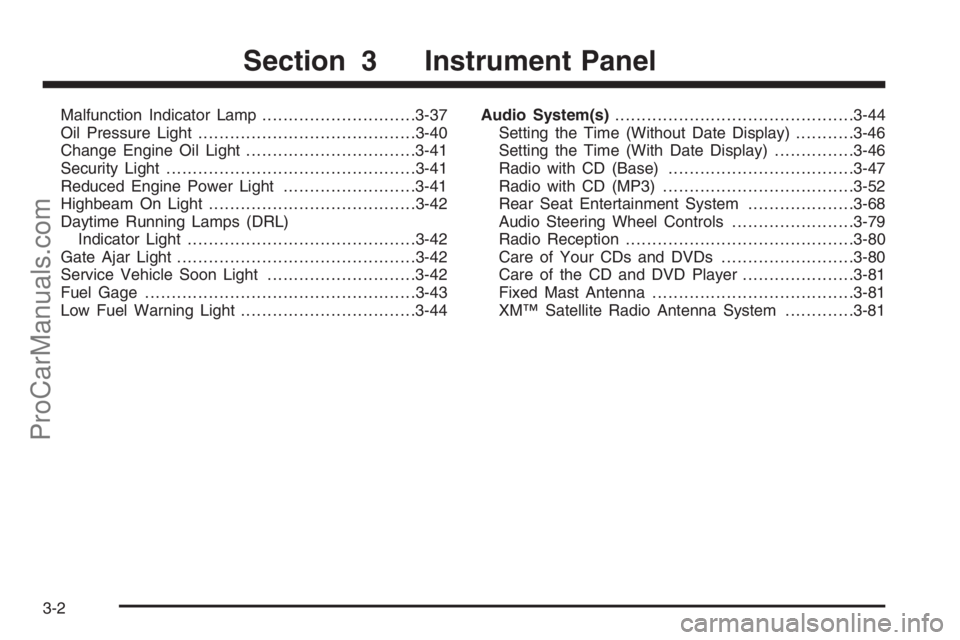instrument panel SATURN VUE 2006 User Guide
[x] Cancel search | Manufacturer: SATURN, Model Year: 2006, Model line: VUE, Model: SATURN VUE 2006Pages: 412, PDF Size: 2.89 MB
Page 76 of 412

The passenger sensing system is designed to turn off
the right front passenger’s frontal airbag if:
the right front passenger seat is unoccupied
the system determines that an infant is present in
a rear-facing infant seat
the system determines that a small child is present
in a forward-facing child restraint
the system determines that a small child is present
in a booster seat
a right front passenger takes his/her weight off of
the seat for a period of time
the right front passenger seat is occupied by a
smaller person, such as a child who has outgrown
child restraints
or if there is a critical problem with the airbag
system or the passenger sensing system.
When the passenger sensing system has turned off the
right front passenger’s frontal airbag, the off indicator
on the instrument panel will light and stay lit to remind
you that the airbag is off.
If a child restraint has been installed and the on
indicator is lit, turn the vehicle off. Remove the child
restraint from the vehicle and reinstall the child restraint
following the child restraint manufacturer’s directions
and refer toSecuring a Child Restraint in the Right Front
Seat Position on page 1-54.If after reinstalling the child restraint and restarting the
vehicle, the on indicator is still lit, check to make sure that
the vehicle’s seatback is not pressing the child restraint
into the seat cushion. If this happens, slightly recline the
vehicle’s seatback and adjust the seat cushion if
possible. Also make sure the child restraint is not trapped
under the vehicle head restraint. If this happens, adjust
the head restraint.
If the on indicator is still lit, secure the child in the
child restraint in a rear seat position in the vehicle if
one is available and check with your retailer.
The passenger sensing system is designed to enable
(may in�ate) the right front passenger’s frontal
airbag anytime the system senses that a person of
adult size is sitting properly in the right front passenger’s
seat. When the passenger sensing system has
allowed the airbag to be enabled, the on indicator will
light and stay lit to remind you that the airbag is active.
For some children who have outgrown child restraints
and for very small adults, the passenger sensing system
may or may not turn off the right front passenger’s
frontal airbag, depending upon the person’s seating
posture and body build. Everyone in your vehicle who
has outgrown child restraints should wear a safety
belt properly — whether or not there is an airbag for
that person.
1-70
ProCarManuals.com
Page 77 of 412

If a person of adult-size is sitting in the right front
passenger’s seat, but the off indicator is lit, it could be
because that person is not sitting properly in the seat.
If this happens, turn the vehicle off and ask the person to
place the seatback in the fully upright position, then sit
upright in the seat, centered on the seat cushion, with the
person’s legs comfortably extended. Restart the vehicle
and have the person remain in this position for about
two minutes. This will allow the system to detect that
person and then enable the passenger’s airbag.
{CAUTION:
If the airbag readiness light in the instrument
panel cluster ever comes on and stays on,
it means that something may be wrong with
the airbag system. If this ever happens, have
the vehicle serviced promptly, because an
adult-size person sitting in the right front
passenger’s seat may not have the protection
of the frontal airbag. SeeAirbag Readiness
Light on page 3-28for more on this, including
important safety information.
A thick layer of additional material such as a blanket, or
aftermarket equipment such as seat covers, seat heaters,
and seat massagers, can affect how well the passenger
sensing system operates. Remove any additional
material from the seat cushion before reinstalling or
securing the child restraint and before a small occupant,
including a small adult, sits in the passenger position.
You may want to consider not using seat covers or other
aftermarket equipment if your vehicle has the passenger
sensing system. SeeAdding Equipment to Your
Airbag-Equipped Vehicle on page 1-73
1-71
ProCarManuals.com
Page 78 of 412

The passenger sensing system may suppress the airbag
deployment when liquid is soaked into the seat. If this
happens, the off indicator in the passenger airbag status
indicator and the airbag readiness light on the instrument
panel will be lit. The system should resume normal
operation after the seat is allowed to dry. If the system
operates incorrectly after the seat has dried, have your
retailer check the system.
{CAUTION:
Stowing of articles under the passenger’s
seat or between the passenger’s seat cushion
and seatback may interfere with the proper
operation of the passenger sensing system.
Servicing Your Airbag-Equipped
Vehicle
Airbags affect how your vehicle should be serviced.
There are parts of the airbag system in several places
around your vehicle. You do not want the system to
in�ate while someone is working on your vehicle.
Your retailer and the service manual have information
about servicing your vehicle and the airbag system.
To purchase a service manual, seeService Publications
Ordering Information on page 7-12.
{CAUTION:
For up to 10 seconds after the ignition key is
turned off and the battery is disconnected, an
airbag can still in�ate during improper service.
You can be injured if you are close to an airbag
when it in�ates. Avoid yellow connectors. They
are probably part of the airbag system. Be sure
to follow proper service procedures, and make
sure the person performing work for you is
quali�ed to do so.
The airbag system does not need regular maintenance.
1-72
ProCarManuals.com
Page 79 of 412

Adding Equipment to Your
Airbag-Equipped Vehicle
Q:Is there anything I might add to the front or
sides of the vehicle that could keep the
airbags from working properly?
A:Yes. If you add things that change your vehicle’s
frame, bumper system, height, front end or side
sheet metal, they may keep the airbag system
from working properly. Also, the airbag system may
not work properly if you relocate any of the airbag
sensors. If you have any questions about this,
you should contact Customer Assistance before
you modify your vehicle. The phone numbers
and addresses for Customer Assistance are in
Step Two of the Customer Satisfaction Procedure
in this manual. SeeCustomer Satisfaction
Procedure on page 7-2.
Q:Because I have a disability, I have to get my
vehicle modi�ed. How can I �nd out whether
this will affect my airbag system?
A:Changing or moving any parts of the front seats,
safety belts, the airbag sensing and diagnostic
module, steering wheel, instrument panel,
ceiling headliner, ceiling and pillar garnish trim,
roof-mounted airbag modules, or airbag wiring
can affect the operation of the airbag system.
If you have questions, call Customer Assistance.
The phone numbers and addresses for Customer
Assistance are in Step Two of the Customer
Satisfaction Procedure in this manual. See
Customer Satisfaction Procedure on page 7-2.
1-73
ProCarManuals.com
Page 80 of 412

Restraint System Check
Checking the Restraint Systems
Now and then, make sure the safety belt reminder light
and all your belts, buckles, latch plates, retractors and
anchorages are working properly. Look for any other
loose or damaged safety belt system parts. If you see
anything that might keep a safety belt system from doing
its job, have it repaired. SeeCare of Safety Belts on
page 5-87for more information.
Torn or frayed safety belts may not protect you in a
crash. They can rip apart under impact forces. If a
belt is torn or frayed, get a new one right away.
Also look for any opened or broken airbag covers, and
have them repaired or replaced. The airbag system
does not need regular maintenance.
Notice:If you damage the covering for the driver’s
or the right front passenger’s airbag, or the side
impact airbag covering (if equipped) on the ceiling
near the side windows, the airbag may not work
properly. You may have to replace the airbag
module in the steering wheel, both the airbag
module and the instrument panel for the right front
passenger’s airbag, or side impact airbag module
and ceiling covering for roof-mounted side impact
airbags (if equipped.) Do not open or break the
airbag coverings.
Replacing Restraint System Parts
After a Crash
{CAUTION:
A crash can damage the restraint systems
in your vehicle. A damaged restraint system
may not properly protect the person using it,
resulting in serious injury or even death in
a crash. To help make sure your restraint
systems are working properly after a crash,
have them inspected and any necessary
replacements made as soon as possible.
1-74
ProCarManuals.com
Page 93 of 412

Lockout Protection
If you press the power door lock switch when the key
is in the ignition and any door is open, all the doors
will lock and then the driver’s door will unlock. Be
sure to remove the key from the ignition when locking
your vehicle.
If the remote keyless entry transmitter is used to lock
the doors while the key is in the ignition, a chime
will sound three times. All doors will then lock.
Liftgate
{CAUTION:
It can be dangerous to drive with the liftgate
open because carbon monoxide (CO) gas can
come into your vehicle. You cannot see or
smell CO. It can cause unconsciousness and
even death. If you must drive with the liftgate
open or if electrical wiring or other cable
connections must pass through the seal
between the body and the liftgate:
Make sure all other windows are shut.
Turn the fan on your heating or cooling
system to its highest speed and select the
control setting that will force outside air
into your vehicle. SeeClimate Control
System on page 3-19.
If you have air outlets on or under the
instrument panel, open them all the way.
SeeEngine Exhaust on page 2-27.
Use your remote keyless entry transmitter or power
door lock switches to unlock the liftgate.
To open the liftgate, lift the handle located in the
center of the liftgate.
2-11
ProCarManuals.com
Page 121 of 412

Instrument Panel Overview...............................3-4
Hazard Warning Flashers................................3-6
Horn .............................................................3-6
Tilt Wheel.....................................................3-6
Turn Signal/Multifunction Lever.........................3-7
Turn and Lane-Change Signals........................3-7
Headlamp High/Low-Beam Changer..................3-8
Flash-to-Pass.................................................3-8
Windshield Wipers..........................................3-8
Windshield Washer.........................................3-9
Rear Window Wiper/Washer...........................3-10
Cruise Control..............................................3-10
Headlamps..................................................3-13
Daytime Running Lamps (DRL).......................3-14
Automatic Headlamp System..........................3-15
Fog Lamps ..................................................3-15
Interior Lamps..............................................3-16
Instrument Panel Brightness...........................3-16
Dome Lamp .................................................3-16
Entry Lighting...............................................3-16
Map Lamps .................................................3-17
Footwell Lamps............................................3-17
Battery Run-Down Protection..........................3-17
Accessory Power Outlet(s).............................3-17
Cigarette Lighter...........................................3-18Climate Controls............................................3-19
Climate Control System.................................3-19
Outlet Adjustment.........................................3-22
Passenger Compartment Air Filter...................3-22
Warning Lights, Gages, and Indicators............3-24
Instrument Panel Cluster................................3-25
Speedometer and Odometer...........................3-26
Trip Odometer..............................................3-26
Tachometer.................................................3-26
Safety Belt Reminder Light.............................3-27
Passenger Safety Belt Reminder Light.............3-27
Airbag Readiness Light..................................3-28
Passenger Airbag Status Indicator...................3-29
Battery Warning Light....................................3-31
Up-Shift Light...............................................3-32
Brake System Warning Light..........................3-32
Anti-Lock Brake System Warning Light.............3-33
Traction Control System (TCS)
Warning Light...........................................3-34
Low Traction Light........................................3-35
Engine Coolant Temperature
Warning Light...........................................3-35
Engine Coolant Temperature Gage..................3-36
Low Coolant Warning Light............................3-36
Section 3 Instrument Panel
3-1
ProCarManuals.com
Page 122 of 412

Malfunction Indicator Lamp.............................3-37
Oil Pressure Light.........................................3-40
Change Engine Oil Light................................3-41
Security Light...............................................3-41
Reduced Engine Power Light.........................3-41
Highbeam On Light.......................................3-42
Daytime Running Lamps (DRL)
Indicator Light...........................................3-42
Gate Ajar Light.............................................3-42
Service Vehicle Soon Light............................3-42
Fuel Gage...................................................3-43
Low Fuel Warning Light.................................3-44Audio System(s).............................................3-44
Setting the Time (Without Date Display)...........3-46
Setting the Time (With Date Display)...............3-46
Radio with CD (Base)...................................3-47
Radio with CD (MP3)....................................3-52
Rear Seat Entertainment System....................3-68
Audio Steering Wheel Controls.......................3-79
Radio Reception...........................................3-80
Care of Your CDs and DVDs.........................3-80
Care of the CD and DVD Player.....................3-81
Fixed Mast Antenna......................................3-81
XM™ Satellite Radio Antenna System.............3-81
Section 3 Instrument Panel
3-2
ProCarManuals.com
Page 124 of 412

Instrument Panel Overview
3-4
ProCarManuals.com
Page 125 of 412

The main components of the instrument panel are the following:
A. Air Outlets. SeeClimate Control System
on page 3-19.
B. Turn Signal/Multifunction Lever. SeeTurn
Signal/Multifunction Lever on page 3-7.
C. Cruise Control Buttons. SeeCruise Control
on page 3-10.
D. Horn. SeeHorn on page 3-6.
E. Instrument Panel Cluster. SeeInstrument Panel
Cluster on page 3-25.
F. Audio Steering Wheel Controls. SeeAudio Steering
Wheel Controls on page 3-79.
G. Windshield Wiper Lever. SeeWindshield Wipers
on page 3-8.
H. Instrument Panel Brightness Control. SeeInstrument
Panel Brightness on page 3-16.
I. Hazard Warning Flasher Button. SeeHazard
Warning Flashers on page 3-6.
J. Passenger Air Bag Status Indicator. SeePassenger
Airbag Status Indicator on page 3-29.K. Fog Lamp Button (If Equipped) or Traction Control
System Button (If Equipped). SeeFog Lamps
on page 3-15orTraction Control System (TCS)
on page 4-10.
L. Audio System. SeeAudio System(s) on page 3-44.
M. Hood Release. SeeHood Release on page 5-11.
N. Power Mirror Control. SeeOutside Power Mirrors
on page 2-31.
O. Power Window Switches. SeePower Windows
on page 2-13.
P. Automatic Transaxle Shift Lever. SeeAutomatic
Transaxle Operation on page 2-19.
Q. Heated Seats Buttons or Footwell Lamps
(If Equipped). SeeHeated Seats on page 1-4or
Footwell Lamps on page 3-17.
R. Climate Control. SeeClimate Control System
on page 3-19.
S. Glove Box. SeeGlove Box on page 2-34.
3-5
ProCarManuals.com